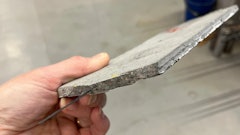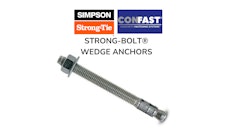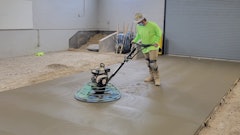
Tying rebar involves handling heavy materials, working in awkward positions, and repeating the same hand twisting motions over and over. All of this can lead to serious wear and tear on the body.
A contractor asked the National Institute for Occupational Safety and Health (NIOSH) to compare the hazards of rebar tying by hand vs. using powered tying tools. (This study did not evaluate the risks in lifting and carrying rebar, which are somewhat different.) NIOSH studied rebar tying during the construction of a freeway bridge deck. Rodbusters’ hand/wrist movements and body positions were measured, first when using pliers to twist 16-gauge wire, and then when using a powered tie gun with 21-gauge wire. The tie gun was used alone, and then used again with a 3-foot extension handle.
The results showed that:
- Twisting with pliers required harmful hand/wrist motions, increasing the chance of a serious injury like carpal tunnel syndrome.
- Unsupported stooping when twisting with pliers at ground level, using both hands, increased the risk of back pain and injury.
- Power rebar tying tools reduced harmful hand/wrist movements.
- Tying rebar at ground level, using an extension handle on a powered rebar tying tool, gave the most protection against back pain and injury
- Using a powered rebar tying tool was faster than hand-twisting wire.
Tool selection tips
Powered rebar tying tools have been available in the United States for more than a decade. Several manufacturers offer the tools in a variety of sizes and configurations. Rebar tying tools are not suitable for all jobs, but contractors are using them for jobs that require a lot of ties, like bridge decks and other flat work.
When selecting any tool, including a rebar tying tool, you will always consider price, ease of use and performance. But also look at safety factors, including possible effects of long-term use on the worker’s body. Safety can have a significant effect on your bottom line.
In choosing a rebar tying tool, look at:
- Tool weight and balance. Is the tool too heavy to hold comfortably? Does it pull the hand forward? Does it have a second handle?
- Hand grip size and shape. Can the tool fit comfortably in the hand? Does it have sharp or hard edges that can dig into the skin?
- Trigger design. Is the trigger pressure all on one finger? Can two or more fingers be used to pull the trigger?
- Working posture. Do you need to flex your wrist when using the tool? Does the tool let you tie rebar at ground level without bending over?
What can managers do?
In its Health Hazard Evaluation Report on rebar tying, NIOSH made four recommendations for mangers wanting to lessen worker health issues related to rebar tying.
- Minimize the frequency and time employees manually tie rebar using the pliers.
- Provide battery-powered rebar tying tools to employees when they tie rebar more than 1 hour per day.
- Provide an extension handle for the powered rebar tying tools for ground level tying.
- Provide employees information describing the signs and symptoms of low back and hand, wrist and elbow disorders
You can read the full NIOSH Health Hazard Evaluation Report on rebar tying at http://www.cdc.gov/niosh/hhe/reports/pdfs/2003-0146-2976.pdf.





























